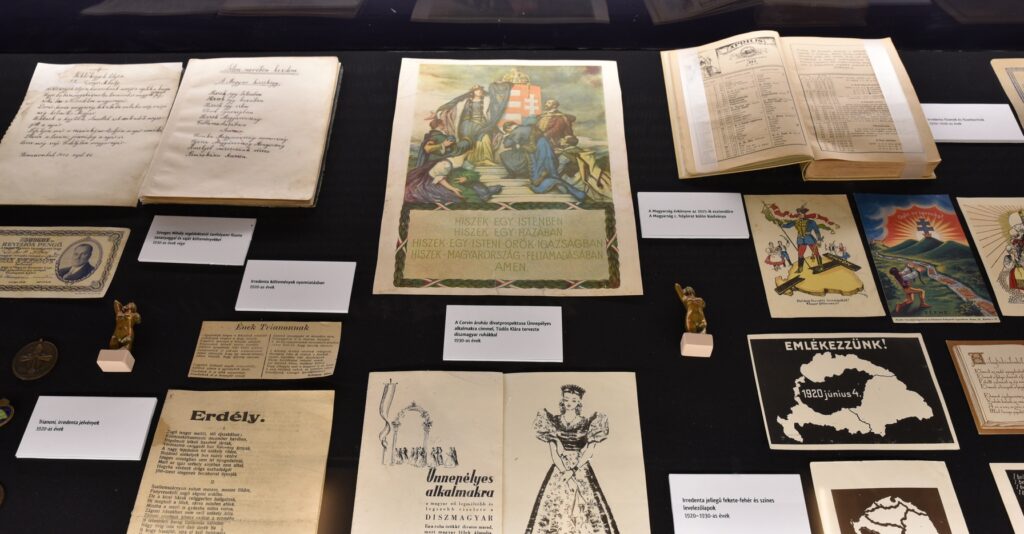The Déri Museum has launched a new exhibition entitled Border Fate and is about the wide ranging effects that the Treaty of Trianon had on the population of Hungary. It builds upon the museums prior virtual exhibition, done for the centenary anniversary of the Treaty of Trianon in 2020. In addition to well-known consequences of the treaty, the exhibition draws attention to lesser-known or partially forgotten events.

As part of the First World War and the peace agreement that ended it, the Trianon peace severely affected Hungary. It lost almost two-thirds of its territory and most of its population. All this left a significant mark on the life of Hungarian society, which could not come to terms with the loss. In Hungary, between the two world wars, the issue of revision was on the agenda, and irredentism permeated everyday life, thinking and art.
However, after World War II, the communist political and ideological system forbade Trianon memory and discourse, and even condemned its spiritual and material memories to destruction. It was only possible to talk and create trianon freely again after the change of regime, from the 1990s onwards.

The exhibition accompanies the change of Hungarian borders and the development of destinies, ie the effects on society, from the revival of the world of “happy times of peace” to the age of territorial feedback. Objects, documents, contemporary photographs and films, as well as recollections help to recall the events of Trianon and its aftermath, to convey the feelings and pain of the people of the era. Accordingly, the exhibition seeks to convey knowledge and influence the emotions of visitors at the same time.
The age of the “happy times of peace” is depicted by the objects of the bathing places, the monuments of the royal cult, in addition to the atlas county map appendices edited by Ignác Hatsek. We have mainly assigned ethnographic objects to the latter, presenting the rich culture of the era in a spectacular way. We recall separately the period from the peace conference to the peace agreement with the help of documents and archive recordings. Details of Apponyi’s speech also emerge, highlighted by maps from different periods.
One of the most personal parts of the exhibition is the piece presenting the world of refugees. The fate of four refugees comes to life with the help of the documents and objects, and a report also shows the former barracks of the Nyulas settlement, where the refugees were housed during the autumn of 1920.

In addition to the world of loss, confusion and refugees, the cult of irredenta was also included in the exhibition, as most of the intellectual and material products were made in the spirit of revisionism and irredentism. With the appearance of the irredenta elements, the mournful, gloomy mood simultaneously intensified and “dissolved”, everyday life, contemporary customs and objects were transformed, new content and meaning were added, all related to the demand for revision, the voicing and expression of injustice. The emphasis on national character was closely connected with the irredenta cult, for example, Hungarian decorations and elements appeared in the clothing. Exhibits include everyday objects and personal items.
In the gallery we present the history of Debrecen between the two world wars. In addition to the losses of the First World War, the city was also affected by the Romanian occupation. All of this, and the Trianon provisions, wore it down, however, after initial uncertainties and stagnation, the city became the center of the region for nearly a decade. The city owed all this thanks to his new geographical position, the generous offer of Frigyes Déri and the Klebelsberg policy, to which the contribution of the city leadership was also indispensable. The huge installation accompanies the fate and development of Debrecen after the First World War, which never forgot the sad memory of Trianon, and maintained the spirit of revision through its associations and monuments. From the life of Debrecen between the two world wars we can get to know the history of the University and the Déri Museum, we get an insight into the life of the association.
The atmosphere of the exhibition is enhanced by the use of special installation elements, as well as excerpts from the diary of the former refugee official from Oradea, Jenő Osváth, which appear at several points in the exhibition. These quotes simultaneously explain events and convey the feelings and thoughts of a contemporary.
When museums can reopen, it will be open to the public until the end of the year (the exhibition is not available online).